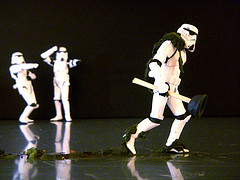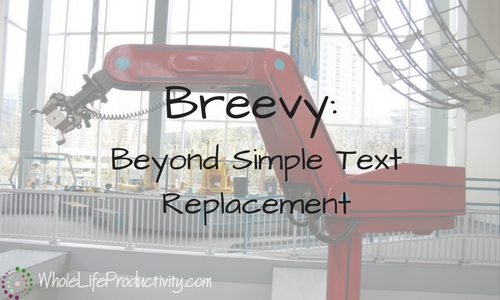
Simplifying Getting Things Done: Projects
Wednesdays are simplicity days at SimpleProductivity blog.

One of the things about making a productivity system that fits how you work is to understand the concepts of other systems. Today we are going to look at simplifying the concept of a Getting Things Done project.
What Is A Project?
According to David Allen, a project is “any desired result that requires more than one action step.” He goes onto say, “this means some rather small things that you might not normally call projects are going to be on your ‘projects’ list.”
In theory, it is a good thing. If you can’t complete it by doing one thing, then somehow you have to be reminded there is something else to do.
The Downside of GTD Project Definition
The problem I see here is that this sort of definition can lead to all sorts of granularity issues. For instance, let’s take changing a light bulb. The discrete steps to this are:
- Get new light bulb from the closet.
- Get step-stool from the pantry.
- Unscrew the burnt light bulb.
- Screw in new light bulb.
- Test the new light bulb.
- Put away step-stool.
- Dispose of old light bulb.
How many of us are going to actually write all those steps out to change a light bulb? It is too much. Sure, if you were to get interrupted, you might not finish, but wouldn’t it be easier to finish the project, and then move on?
How I See A Project
To me, I think a project is a series of actions that require different areas of action. These areas of action could mean moving to a specific piece of machinery (i.e. a computer) or a different physical area.
In this case, our project of changing a light bulb would have one step: change the light bulb. No project.
If we had to purchase a new light bulb first, then it would morph into a project, because we would have to go to the store to purchase a light bulb, then install it. Two physical locations, one project.
Different Types of Projects
It seems to me that the whole point of a project is to accomplish an outcome. If you have never done this outcome before, you will have to think it through.
On the other hand, there are a lot of things that most of us do that repeat. For instance, taking out the trash. It happens every Thursday in my household, and it consists of emptying the small cans into the large one, hauling the large one to the curb, and every other week, doing the same to the recycling.
I shouldn’t have to clutter up my project list with something like this…it doesn’t require any thought after the first time you do it; and yet I need to be reminded of the needed outcome – getting the trash to the curb.
To me, these things are maintenance projects. They need to be done regularly, but after the first time, I don’t have to rethink the method, and I don’t have to figure out what the desired outcome is, or the steps to accomplish it. All I should need is a reminder to perform the series of actions on the appropriate day.
Taking out the trash on Thursday is very different in approach than redesigning a web site. It isn’t unimportant, because it must be done. Yet it isn’t something I should put a lot of effort or energy into managing.
Some other examples of maintenance projects:
- Menu planning/grocery shopping
- Power-washing the deck and porch every spring
- Laundry
- Cooking dinner/doing dishes
- Household cleaning
- Daily walks
- Sending birthday cards
As you can see, each one of these is time sensitive and contributes to the quality of life; yet it does not require deciding outcomes or the steps to take.
By grouping steps together by location or equipment, and making the distinction between maintenance and other projects, you can simplify your project list.
Photo by JD Hancock. Licensed under Creative Commons.
I’m just going to say up front that I think David Allen’s definition of a project actually leads to more work.





5 Comments
Bubba
I’d say it hinges on your understanding of what constitutes an “action step”. Since the main purpose of GTD is maintaining mental clarity about our tasks (“mind like water”), it makes sense to conceptualize a single action step as a task we can perform without first having to think through how to perform it. If you know you have spare light bulbs on hand and where they’re stored, then you don’t really have to think about how to perform “Change light bulb” and you can consider it a single action step. If you can’t proceed before buying a spare bulb at the store, then that’s almost certainly going to be something you have to think about as a separate action step. (And then while you’re in the @Errands context, it’s very helpful also to have “Buy milk and eggs” on that context-based task list we call a grocery list.)
LJ Earnest
Yes, but David Allen defines a next action as the “next physical action” to be taken. This means that according to his definition, it would have all the steps.
The point was that the definition that David Allen uses is too narrow and is cumbersome.
Fil Salustri
If you’ve never changed a light bulb before, you might want to think of it as a project at first (i.e. having multiple tasks). Eventually it wouldn’t be a project – so then you just delete the project and use a single task – “change the light bulb.”
Also, in the general case, one may find that a whole project is actually a task in a larger project.
So I prefer to simply be able to nest tasks within other tasks. Many apps allow one to rather arbitrarily shuffle tasks up and down a hierarchy of nested tasks. Doing this removes the meta-work of deciding whether an item is a task or a project, and focus more (at least, imho) on the relationships between tasks.
LJ Earnest
I agree with you – once you have done the thinking, things don’t need to be spelled out.
I think your system of task hierarchies does remove the necessity of deciding on projects vs tasks. However, have you ever had a project linger because it never got to “done”? How do you know when you can wrap up something that has multiple sub-tasks? How do you handle last-minute additions (dusting the fixture while changing a light bulb)? Do those extras ever get in your way?
I’m asking because I truly want to know how other people handle what I know in my industry as “scope creep” where the project definition keeps expanding and never gets to “done”. Or perhaps there is truly no discreet unit of work, and that all the classifications we put on something to make it a project are arbitrary?
Rebekah O'Neal
Perhaps another way to differentiate between an actual project or just a task is according to how it fits on a to-do list. For example, checking you post office box each week is a simple chore to add to your to-do list with no elaboration necessary. However, mailing Christmas packages is definitely a complex task that has multiple and varied tasks necessary to accomplish it which sure is not something simple to check off the to-list. I think the more thinking, planning, and decisions are involved with an activity, the closer it is to a project instead of just being something on your to-do list.